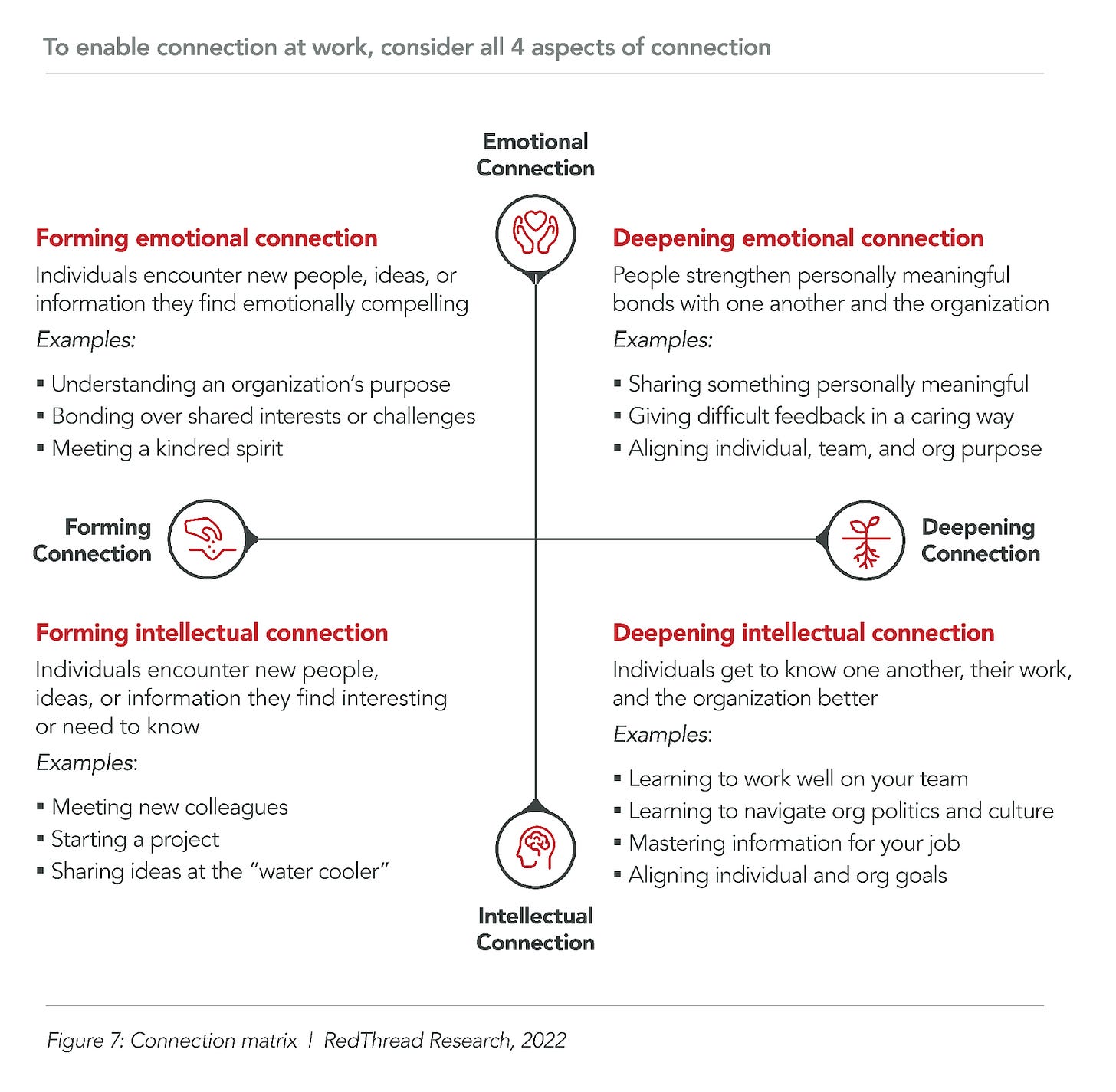#102: What Kind of Career Destination is Your Company?
On Career Growth, Fostering Connection, Career Tools, Layoffs and More
Virtual Event: Strengthening Relationships at Work (Tuesday, January 10th) This Tuesday, I’m hosting a virtual event for my community about strengthening your relationships at work. If that is your jam, we have a few spots left and we’d love to have you join. You can register here
Hello, and welcome to this week’s newsletter. This week, I’ll tackle three things related to talent and the workplace:
What Kind of Career Destination is Your Company?
Connection in the Workplace
Investing in Career Infrastructure
1.What Kind of Career Destination is Your Company?
I grew up in Rochester, New York, which was home to the titans of yesteryear in Kodak and Xerox. Growing up, I heard stories of the “heyday” in the 1970’s and 1980s where there were literal neighborhoods full of employees who worked at these companies, and people often carpooled to work together to go to Kodak’s massive campus. Both companies were synonymous with lots of investments in their respective communities, and employees had long tenures within the organization due to the mobility options and their general sense of loyalty.
At one point in time, Xerox, Kodak, and many other companies were career destinations. Places that people wanted to go, stay, and grow. Times and changed, and it feels like they are more companies today that are not like Kodak and Xerox than that are. For companies, there are no more pensions, there is a much different view on the employer-employee relationship, and the leadership and training programs the likes of many of these companies went away for many.
Furthermore, society, and employees have also changed. Technology has more opportunities for advancement & discovery (ex: LinkedIn, Glassdoor) and as a result, people can search for and talk more openly about jobs. Furthermore, there are a diversity of different views on how to grow a career. While some may want to “climb” the career ladder, there’s others who want the lattice, the portfolio, or find meaning in the freelance or solopreneur path.
So how does someone figure out what kind of company, based on what they are looking for out of a job and career at the stage they are in life?
Last Fall, Harvard Business School, The Burning Glass Institute and the Schultz family foundation came out with the American Opportunity Index, an instrument that ranks large companies by how well they create economic mobility for their workers.
The index measures how well companies create opportunities for workers open to non-college graduates across access (Getting in), wage (pay) and mobility (movement)
What’s interesting about the framework is that it doesn’t simply rank companies but also classifies their model of growth. After evaluating their data set, they came back with six main categories of opportunity creation
Top 50
Career Launchpad - Great for starting from
Career Stability - Great for staying and thriving
Career Growth - Great for advancing from within
Growing Talent - Great for growing their own talent
Advancement without a degree - great for advancing without a college degree
The thinking here is to help people make better decisions about going to companies that align to what they are looking for, and also to help companies figure out how they can get better.
Given that the days of company pensions and lifetime employment are gone, I think it’s on the onus of companies to come to the table with a better value proposition for why employees should come work there. The trick is, not just defining what that value proposition is, but A) continuously aligning your programs and processes to it, and B) being definitive about what it is and what it isn’t. The framework is a great starting point to help companies decide what their philosophy is, and how to start supporting that so candidates can be aware. If you can’t promise career stability or that’s not your approach, then don’t! And if you’re an employee that loves career stability, then try to find a company that actually offers it, not one that is focused on a different model.
Being clear and consistent about what it is helps employees and prospective workers understand the deal they are signing up for, and if it’s for them. Being definitive about it ensures you aren’t trying to be everything to everyone thus disappointing employees who don’t get what they want and end up leaving.
I think the days of companies like Kodak and Xerox are long gone, and that’s a good thing. But in today’s workplace and especially in competitive talent markets, its important to define the kind of career destination your company wants to be, and then to start acting your way to becoming it.
2.Connection in the Workplace
I’ve been digging into some research into relationships and feelings of connection in the workplace. In the world of work today, knowing the right people and feeling connected to the organization are not just good for employees, it’s good for companies. Many people conceptually get this, but intentionally making this happen isn’t always done effectively inside of organizations. Throw on top hybrid work and lots of new hires, and no wonder why people don’t feel connected and engaged.
Some recent research from Readthread and Enboarder might help us think about this. According to their study, the companies that do prioritize connections stand to gain significant advantages, such as 5.4x more likely to be agile, 3.2x more likely to have satisfied customers, and 2.3x more likely to have engaged employees.
Even more so is one of their frameworks (see below) for helping people think about the type of connection they want, and the best way to achieve it. A lot of what we have now, are companies just telling people to come to the office to connect, which can happen, but doesn’t always. This prescriptive framework is a great way for managers and leaders to help their employees think about connection.
For some upcoming work I am doing, I’ve started thinking through my own framework around this same exact topic - for me, employee connection comes down to four things:
Connection to Self
Connection to Role
Connection to Manager/Supervisor
Connection to the Organization
Having your employees think about this might be a good first step to helping them understand where they are today, and where they think they need to be in order to feel effective and engaged in their work.
3.Investing in Career Infrastructure
I spent 5 years at Salesforce prior to becoming self-employed, so hearing this week’s news of the layoffs was a tough one. As I saw post after post on my Linkedin feed of some incredible colleagues sharing they had been let go it was to feel anything but empathy for such a difficult thing.
In many cases, I saw employees, who had been at the company for over 10-15 years, star performers, hungry up and coming new hires, and incredibly respected people leaders get let go. Not to mention, a lot of employees who feel (felt?) a sense of pride and connection to a company that changed the technology industry, and a deeper connection to their former peers and colleagues. I can only imagine what the next few months will be like for those involved.
There’s a lot of takes to be had on this topic. Railing on capitalism, questions about company leadership, the way layoffs are conducted, the role of activist investors, etc. But the lens I’ll go with is this: These events make me reflect on the importance of new models, infrastructure and tooling to support employees across the entirety of the career lifecycle. Expecting that people will have the knowledge and support they need from college to navigate through the rest of their career in today’s world of work is not going to cut it.
This is not a conversation about skills or upskilling (although those are important) but rather, providing people with operating tools to navigate through their careers in ways that work for them, and giving them access to the resources, programs, and social capital to do that.
The incredible outpouring of support, from the linkedin posts to the spreadsheets of companies that are hiring is heartwarming and I wholeheartedly believe when Ann Helen Peterson says that “community is the only way forward.”
While I am grateful and appreciate everyone who is supporting those right now, when our answer to helping people is a crowdsourced spreadsheet of companies hiring I think it shows just how much more opportunity we have collectively, to do better.
While work and a career is ultimately up to the individual, none of us live in a vacuum and we all exist in a system that is much bigger than ourselves. Building off of what we have today (ex: outplacement services, COBRA benefits, Linkedin spreadsheets) supporting employees through the lifecycle of their careers has ways to go.
It wasn’t until 1 bad performance review and coming across a great manager & mentor when things started to shift. From there, I found books by Lindsey Pollak, Jenny Blake, and Erica Dhawan. I connected with my own career communities, I started writing about careers, and eventually got into business school which gave me the tooling and infrastructure to navigate my careers and work.
It all started to click, so much so that after my work study job as a career coach, I actually started doing career coaching and training myself, and serving as an internal career development advocate internally within both Salesforce and Deloitte.
Since then, I’ve gone on to advise thousands of employees on their careers, and hundreds of leaders about building companies that unlock the potential of their talent, and while many of these people are incredibly talented, many still feel they are lacking in the knowledge and support to navigate their careers. Even when I talk to people who are “successful” many of them talk about how they often feel lost themselves.
There is some hope, namely, in some of the existing tools, programs and communities that exist. In Season 1 of the Edge of Work, I interviewed David Fano of Teal, who is trying to build career tools to support employees through their careers. He shared some of their recent wins from the year, and he’s seeing some promise.
Furthermore, companies like IBM are building returnship programs, and offering a mixture of training, pathways and resources to hire and move talent around who have taken a break in their career.
And I’ve written extensively already about career communities, which can provide a third place for employees to build relationships, knowledge, and social capital to find new opportunities and relationships that advance their career.
As a mid 30 something millennial, I think I am finally old enough to say “back in my day,” but when I started my career, I was lost and struggling to find my footing even when I had so much going my way. I was a college graduate with a great network and working at a fantastic organization. Despite this, it was still incredibly challenging for me to navigate through the world of work. With additional infrastructure, tools, and programming to support employees across their career lifecycle, we can ensure that at each step of the journey, the highs and the lows, there is a safety net to enable people to move throughout their careers to find the next step, and allow talent to find opportunity and vice versa. That to me seems like a great place to start.
Thanks For Reading, and before you go - If you’re company is looking for help in developing and retaining talent, or a speaker for your conference, I’d love to work with you: Here is how I might be able to assist:
Team Trainings & Professional Development
Support Your Offsites & Meetings
Leadership & Learning Programs
Feel free to contact me directly for more details!
That’s all for this week. Have a great week!
Al




